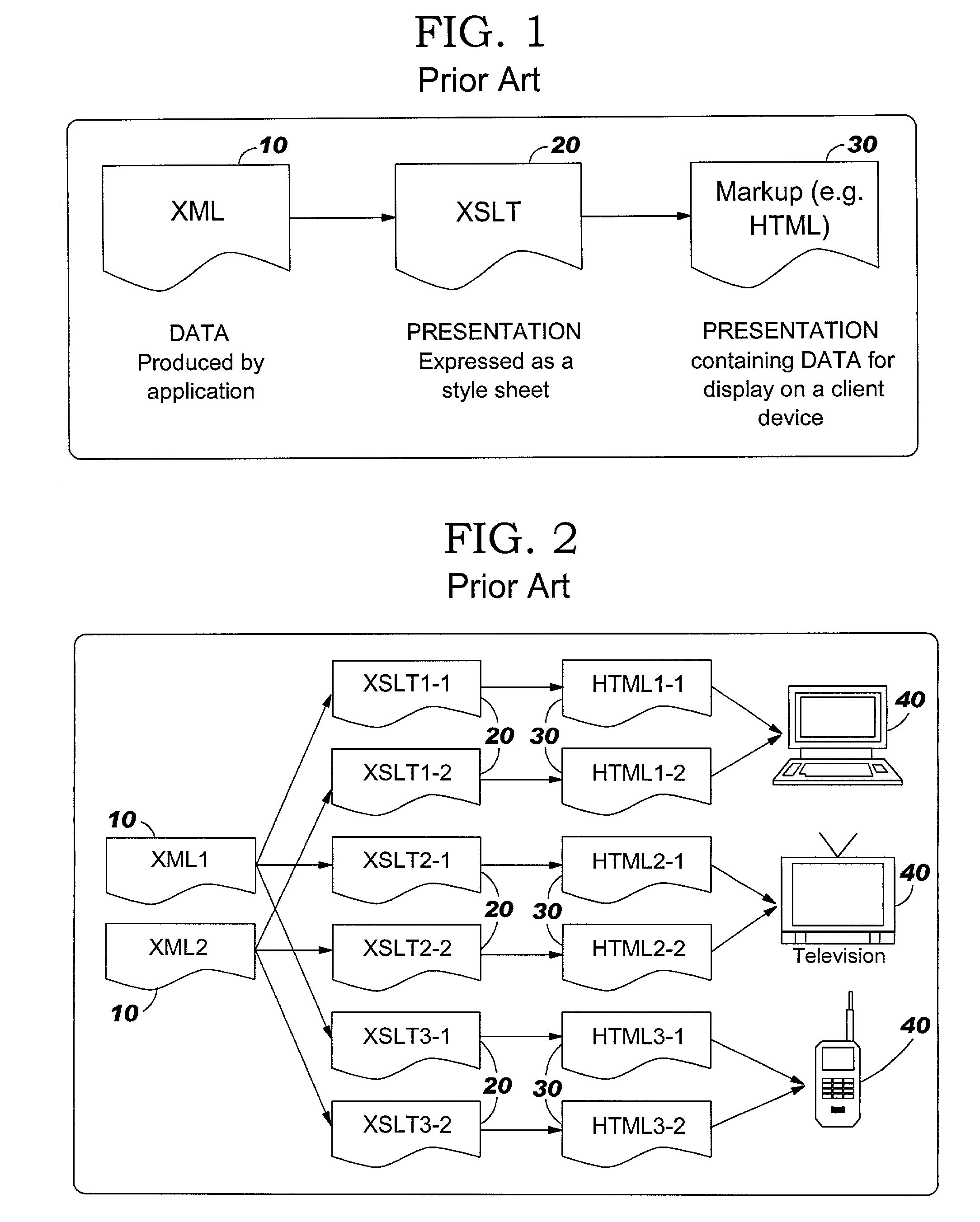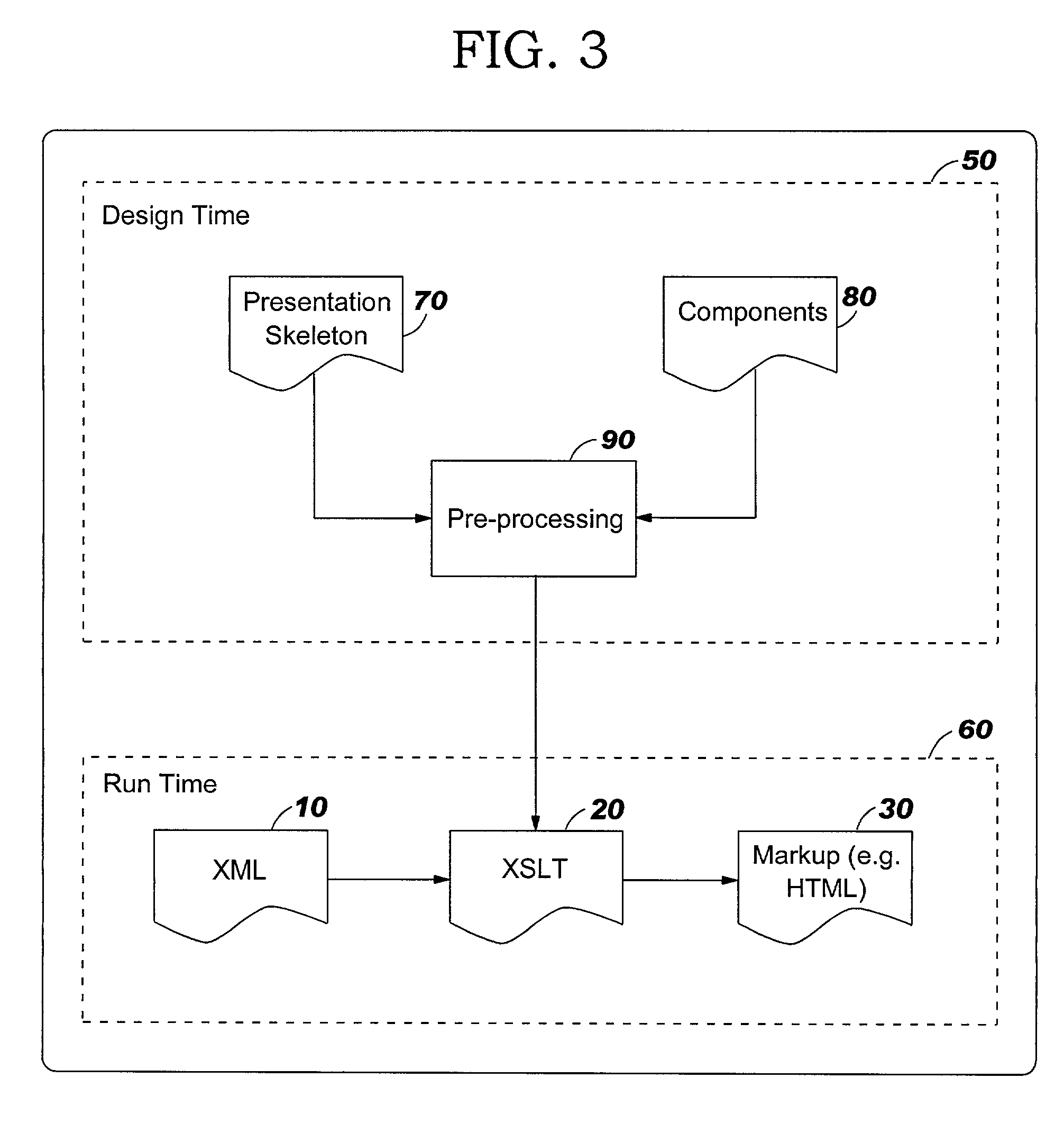[0011] In addition to generally reducing the effort of generating style sheets and helping to ensure consistency within a
style sheet and between style sheets, another
advantage of the present invention is that it is possible to produce presentation skeleton files directly from the
storyboard files which are often generated by design agencies to demonstrate Web sites statically before they are constructed for real. Thus, the present invention provides a
route from initial Web site design to final implementation for multiple output devices.
[0012] In a first aspect of the invention, there is provided a method of generation of a
style sheet for applying presentation characteristics to
Web page content for presentation by a presentation device, the method of generation including the steps of: responsive to specified
Web page presentation characteristics, generating a Web page presentation skeleton comprising a page
layout definition which includes a representation of a subset of the specified presentation characteristics and references to one or more style sheet components corresponding to a second subset of said presentation characteristics; and performing one or more style sheet transformations on the Web page presentation skeleton to replace said references with the corresponding style sheet components.
[0013] Preferably, the referenced style sheet components include style sheet components (for example,
XSL statements) for applying presentation characteristics to dynamic
XML data which is retrieved from a
Web server and inserted into a Web page at run time.
Dynamic data in this context is data which may be updated on the
Web server such that it is necessary to retrieve it from the
Web server at run time to ensure that only up-to-date data is used. The referenced style sheet components preferably include, additionally or alternatively, one or more blocks of presentation markup language comprising either device-specific markup or markup which is repeated in other Web pages.
[0014] The separation of certain style sheet components from a `presentation skeleton` page layout definition, followed by subsequent transformation to create a final style sheet, simplifies style sheet generation since presentation skeleton files can be created relatively easily from input
HTML, especially if complex style sheet components are predefined and provided within a style sheet generator CASE tool. Furthermore, the Web page layout information and component references of a presentation skeleton can then be reused for different types of
output device by using alternative device-specific markup components. The invention also enables easier modification of Web page presentation and helps to ensure consistency, since style sheet components that are referenced multiple times only need to be modified once for a consistent change across the Web page or Web site.
[0015] The Web page presentation skeleton preferably comprises a markup language file including markup tags which are the references to separately-stored style sheet components. In one embodiment of the invention, a set of
XML tags are defined for inclusion in Web page layout definition files to identify specific
XSL components and other presentation markup components and to indicate locations in which to insert the identified components. The style sheet components are inserted in place of the tags as part of an
XSL transformation, or a sequence of XSL transformations, subsequent to the steps of designing the Web page and creating the layout definition, to create a style sheet. The style sheet components may be created by a Web page designer or may have been created previously as an independent operation and then held in a style sheet component repository (for example, within a CASE tool) for use when creating XSLT style sheets. A presentation skeleton file is preferably built for each combination of a Web page and a distinct markup language (such as
HTML or WML) to define how the page will look in a given markup language but, unlike the final style sheets, presentation skeletons are not tied to the detailed requirements of an individual target
display device.
[0016] The set of style sheet components may include XSL components for transforming any input
XML items, but preferably include XSL statements to dynamically insert XML content at run time and / or components which introduce device-specific markup. The former serves to separate out a category of complex components from the basic page layout since selections, sorts and reordering of input XML is relatively complex, while the latter allows the presentation skeleton to be generic and hence reusable for different device types within a class of devices (for example those which present data using WML decks, or the class of devices which present
HTML). Advantageously, style sheet component references are also used to reference style sheet components which appear on more than one page in the site, both removing repetition when designing the page layout for a
client device and helping to ensure consistency of
look and feel within a Web page or across multiple pages. The invention facilitates ease of management of the presentation of Web page content across the application.
 Login to View More
Login to View More  Login to View More
Login to View More 


